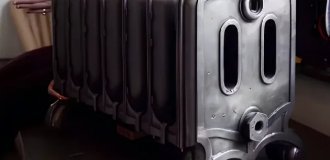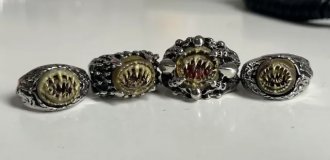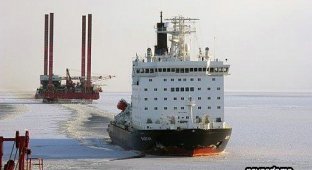60 years ago, the icebreaker Lenin, the world's first nuclear-powered surface ship, launched. "Lenin" became the leader in a special class of domestic ships that spend their lives among the Arctic ice, on the difficult routes of the Northern Sea Route.
The first of its kind.
On December 5, 1957, the weather in Leningrad was not the most “ice-breaking”: it was drizzling with cold rain, interspersed with flying charges of wet snow. The shipyards of the shipyard named after Andre Marty (a few days will pass, and it will regain its historical name "Admiralty Plant") launched the icebreaker "Lenin" - the world's first surface vessel with a nuclear power plant...

The resolution on the construction of a nuclear icebreaker was adopted by the USSR Council of Ministers on November 20, 1953. The need for such an icebreaker was felt very urgently. The fuel reserves of diesel icebreakers operating in the mid-20th century were enough for a maximum of a month's sailing, which was not enough for northern navigation. Therefore, a ship was needed that could accompany convoys of ships for a longer period of time. On average, a nuclear icebreaker can operate on routes for 6-8 months without a break, and if there are special tasks, up to 12-14 months.
After the decision was made, the project was submitted for development to the Central Design Bureau No. 15 (TsKB-15, currently OJSC TsKB ICEBERG), the development was led by chief designer Vasily Neganov.

Under the leadership of scientist Igor Afrikantov, a nuclear installation was designed. The shape of the hull contours was worked out in the ice basin of the Arctic and Antarctic Research Institute. Ship turbines were created at the Kirov plant, the main turbogenerators for the icebreaker were built by the Kharkov Electromechanical Plant, and electric propulsion motors were built by the Leningrad Elektrosila plant.
In total, 30 research institutes, 60 design bureaus and more than 200 industrial enterprises were involved in the construction of the nuclear icebreaker "Lenin". This extensive work was led by physicist Anatoly Alexandrov, the father of the first nuclear submarine, which was put into service a year earlier.

The first of its kind... This formulation, familiar from childhood, also contains a catch during the struggle between two systems. Igor Kurchatov also launched “Europe’s first nuclear reactor” in December 1946, because the first reactor as such had already been launched in the USA. The first ship with a nuclear power plant was also made in the USA. It was the submarine Nautilus.
The Soviet Union, relying on the creation of a nuclear icebreaker, solved two problems at once: it worked out the use of reactors on the surface fleet and commissioned a ship, the need for which for Arctic navigation was absolutely impossible to overestimate.

The laying of the icebreaker "Lenin" took place on August 24, 1956 in Leningrad (now St. Petersburg) at the Admiralty Plant. On December 5, 1957, it was launched and was being completed near the wall of the plant. In August 1959, the physical start-up of the reactors took place. On September 12, the nuclear-powered submarine began sea trials in the Gulf of Finland.
The first captain of the icebreaker was Pavel Ponomarev.
On December 3, 1959, the tests of the nuclear icebreaker "Lenin" were successfully completed, and the state flag of the USSR was raised on it. From this date, not only the biography of the first nuclear icebreaker is counted, it is celebrated as the birthday of the domestic nuclear icebreaker fleet.

The nuclear-powered icebreaker "Lenin" combined all the latest achievements of Soviet scientific thought; during its construction, new, especially strong hull steel was used, and new types of semi-automatic and automatic cutting and welding were used. One of the original technical solutions of the icebreaker "Lenin" was the trim system. Diesel icebreakers often got stuck in ice, not only with their bow or stern, but also with their sides. To avoid such a danger, special ballast tanks were installed on the nuclear-powered ship; if ice pinched the ship, water was pumped from one side to the other. The icebreaker consistently tilted, pushed apart and broke the ice. A similar system was located at the bow and stern, that is, if necessary, the ship could increase the pressure on the ice as the ship moved.

The nuclear icebreaker "Lenin" is a smooth-deck vessel with a length of 134.0 meters, a width of 27.6 meters, a side height of 16.1 meters and a displacement of 16.0 thousand tons (without ballast) with an extended middle superstructure and two masts, as well as in the stern part - a take-off and landing platform for ice reconnaissance helicopters. It has, in the central part, a nuclear steam-generating plant of the water-water type, producing steam for the four main turbogenerators. The latter supply direct current to three propulsion electric motors, which drive three propellers (two onboard and one middle) of a particularly robust design. The power plant capacity is 32.4 megawatts (44.0 thousand horsepower). The maximum speed in clear water is 18.0 knots (33.3 kilometers per hour) and two knots (3.7 kilometers per hour) in ice more than two meters thick.

The crew were provided with good living conditions for a long Arctic voyage. The cabins are designed for one to two people. The ship had a sauna, a music room with a piano, a library, a movie screening room, and a smoking room. The interior of the nuclear-powered ship was completely decorated with Karelian birch and Caucasian walnut.
Radiation safety of the icebreaker personnel and the environment was fully ensured. The nuclear-powered ship was designed in such a way that a thick layer of water, steel plates and concrete reliably protected the operating personnel from radiation.

Already during its first use, the Lenin icebreaker demonstrated excellent performance, thanks to which it was possible to significantly increase the navigation period. The first Arctic navigation of a nuclear icebreaker began on August 19, 1960 and lasted three months and 10 days. During this time, he traveled more than 10 thousand miles, of which about seven thousand were in severe ice conditions, and guided 92 ships through the Kara Sea and the Laptev Sea.

The main event of the next Arctic navigation in 1961 for the crew of "Lenin" was the landing of polar explorers of the drifting station "North Pole-10" on the ice floe. Previous polar stations were landed on the ice with the help of airplanes.
In just the first six years of operation, the icebreaker covered over 82 thousand nautical miles and carried more than 400 ships. During this time, during the trial operation of the nuclear power plant on the icebreaker, its design flaws, problems with the configuration and layout of the equipment were revealed. In addition, there were cases of equipment failure.

In 1966, based on the results of operation, it was decided to replace the old three-reactor nuclear steam generating plant with a more advanced two-reactor one. The replacement of the nuclear power plant of the icebreaker "Lenin" took place in the 1967-1970s at the Zvezdochka enterprise in Severodvinsk. For this purpose, a special method was developed for the aggregate removal of the entire nuclear installation without violating its tightness at the burial site through a hole cut in the bottom of the ship. Such an aggregate unloading of the icebreaker's reactor compartment made it possible to reduce the dismantling time of the installation and its costs, and eliminate the possibility of radiation exposure of personnel.
To fit and dock the new reactor installation into the icebreaker's hull, 204 of the ship's 675 rooms were re-formed or completely refurbished. During the modernization, 6.2 thousand units of new mechanisms and equipment were installed, including over 30 prototypes of the main equipment. After all the work was completed, an acceptance certificate was signed, and on June 21, 1970, the icebreaker "Lenin" set out for Arctic navigation.

In the same year, the nuclear-powered icebreaker and its crew began the first extended navigation on the main route of the Northern Sea Route Murmansk-Dudinka-Murmansk. Six months later, the icebreaker made an early high-latitude passage along the Northern Sea Route to the port of Pevek. In 1976, he made the first Yamal experimental flight to Cape Kharasavey.
The icebreaker exceeded its project lifespan by five years and worked on ice routes for 30 years. During this time, 3,741 transport and icebreaking ships sailed in the Arctic ice, traveling 654.4 thousand nautical miles (including 563.6 thousand in the ice) - a distance that amounts to 30 trips around the world along the equator.
The nuclear-powered icebreaker "Lenin" confirmed that its capabilities in the Arctic latitudes are much greater than that of any other ship on the planet; during its operation it has set more than one world record. As a result of the commissioning of a nuclear icebreaker, navigation in the western region of the Arctic was extended from three to 11 months.

By the Decree of the Presidium of the Supreme Soviet of the USSR dated April 10, 1974, the nuclear icebreaker "Lenin" was awarded the Order of Lenin for its great contribution to the Arctic transportation of economic goods and the use of atomic energy for peaceful purposes.
Foreign delegations visited the icebreaker even during its construction and testing. Cuban leader Fidel Castro, British Prime Minister Harold Macmillan and then US Vice President Richard Nixon were on board.
In the ship's log you can see the autographs of Yuri Gagarin, as well as Alexandra Pakhmutova. She performed the song “Tired Submarine” for the first time on the icebreaker’s piano.

The icebreaker was withdrawn from Atomflot service only in 1989, and it was reported that it was more likely under the pressure of perestroika radiophobia caused by the Chernobyl disaster than for real engineering reasons.
The threat of disposal loomed over it. However, veterans of the nuclear icebreaker fleet and public figures of Murmansk managed to defend it from destruction. The Rosatom state corporation, which has owned the country's nuclear icebreaker fleet since 2008, financed the restoration of the nuclear-powered ship, its radiation cleaning and its berth at the Murmansk Marine Station. After lengthy technical measures and restoration, on December 3, 2009, on the day of the 50th anniversary of the Russian nuclear icebreaker fleet, a museum was opened on the icebreaker "Lenin".
It became the first domestic monument ship with a nuclear power plant.























